Sunday, 16 June, Musée Grévin, the Mint, and Pur'
Written 19 June 2019
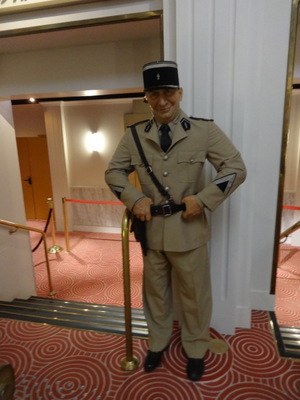
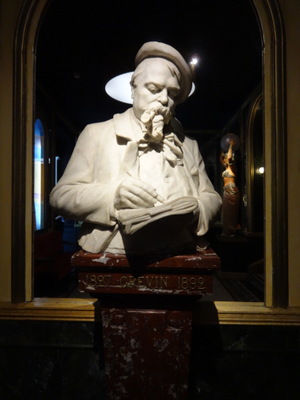 Okay, time to break down and visit the Musée Grévin. We've passed it by many times, and have twice stayed at the Hotel Chopin, literally next door, without ever going in—it seemed so touristy—but if we're mopping up Paris attractions we've never visited . . .
Okay, time to break down and visit the Musée Grévin. We've passed it by many times, and have twice stayed at the Hotel Chopin, literally next door, without ever going in—it seemed so touristy—but if we're mopping up Paris attractions we've never visited . . .
Besides, it attracts as many French tourists as others. It is, among other things, the successor to Madame Toussaud's, featuring wax figures of many, many famous people, modern, historical, fictional and real. So we got (what now passes, for us, as) a good start in the morning and got there a little before 11 a.m. The advance tickets I'd bought were not timed, but they were good for only one entry. Not a problem as it turns out, because it's not one of those museums where you wander around at liberty—it has a prescribed route that is supposed to take about 1.5 hours, so no need to go out for lunch and come back.
Just inside, we were greeted by this figure of Louis de Funès (frequently voted France's favorite actor), in his well-known recurring comic role as Gendarme Ludovic Cruchot. The Cruchot movies are fun, but my favorite role of his will always be Victor Pivert in The Mad Adventures of Rabbi Jacob.
The bust is of Monsieur Grevin himself. Gotta look him up and figure out how he got into the wax museum business.
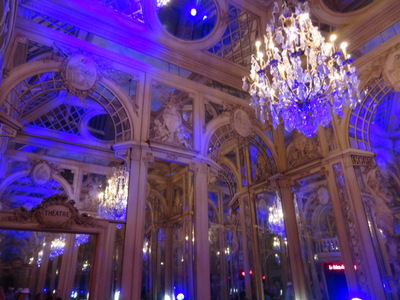
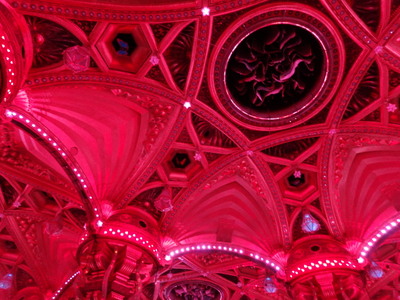 The first stop, which also serves to meter the number of people who enter the rest of the route at a time, is the hall of mirrors, a round room in which spectators lean against a circular wall provided for the purpose under an ornate eight-faceted dome paneled in mirrors.
The first stop, which also serves to meter the number of people who enter the rest of the route at a time, is the hall of mirrors, a round room in which spectators lean against a circular wall provided for the purpose under an ornate eight-faceted dome paneled in mirrors.
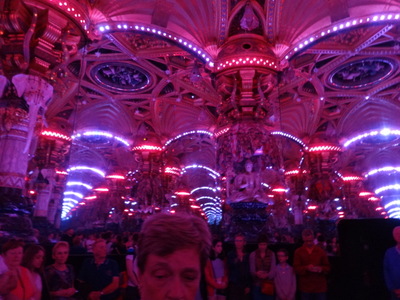
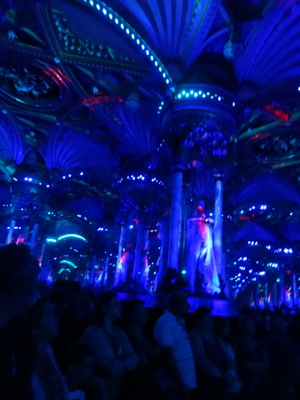
The original was apparently built in 1908 as a replica of one built for the 1900 Universial Exposition, but it's been renovated and redecorated since. Four columns columns purport to support the dome but are actually decorative elements. When we entered, they were adorned with elephant heads and Hindu gods, all painted a flat speckled gray. When all the people were in place, the lights went out, the music came up, and strings of colored lights concealed in the columns and the ribs of the dome came on, blinking, flashing, changing colors, etc. Concealed projectors shown on the statuary, turning it all glittery. The mirrors magnified the effect, causing the lights and sparkles to echo on all sides off into infinity.
The lights went out again, and when they came up, the columns had been replaced with cascades of flowers and foliage, over which the lights played and which were again echoed as far as the eye could see in the mirrors.
The third time, when the lights came on, the thick columns had been replaced with round platforms, each surrounded by three slender columns and supporting elaborately costumed mannequins.
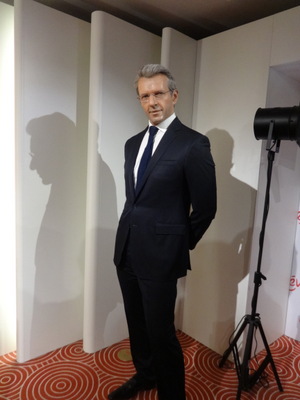
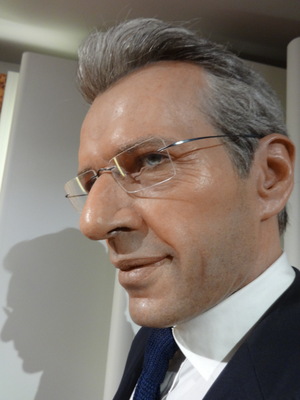 Then came a long series of rooms where wax figures were grouped in rough categories, e.g., the red carpet, politics, media, sports, music, fashion, fictional, scientific, culinary, historical, theatrical, etc., etc. I assume the figures are still actually made of wax, but they may be using more modern materials this days. In any case, some of them are amazingly life-like. I was a little surprised they don't hire mimes to pose as wax figures so as to startle you every now and then by moving, but maybe they don't have to—it was hard enough telling the figures from the tourists posing with them for photos!
Then came a long series of rooms where wax figures were grouped in rough categories, e.g., the red carpet, politics, media, sports, music, fashion, fictional, scientific, culinary, historical, theatrical, etc., etc. I assume the figures are still actually made of wax, but they may be using more modern materials this days. In any case, some of them are amazingly life-like. I was a little surprised they don't hire mimes to pose as wax figures so as to startle you every now and then by moving, but maybe they don't have to—it was hard enough telling the figures from the tourists posing with them for photos!
One of the first we encountered was this distinguished-looking guy. Unfortunately, I hadn't yet realized where to look for the labels (you can see his behind his feet, a gold medalion set in the carpet, but I didn't get a separate photo of it, and I can't blow it up enough to be legible, so I don't know who he is. But his face struck me as one of the most lifelike, so I took a close-up as well. A news presenter maybe? Anybody have a clue? Dan Simberloff, do you know?
Al Pacino was in this section, along with several French actors and celebrities that I didn't recognize.
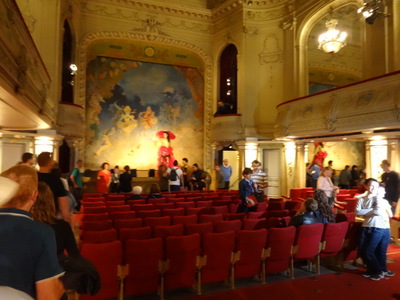
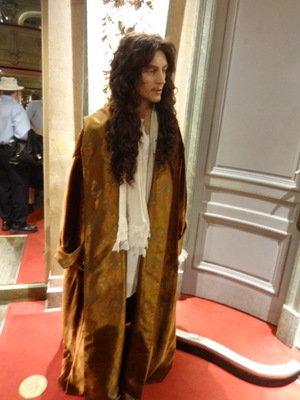 Here, we're in a model of a famous French theater (I didn't catch which one). The slightly bedraggled figure at the right is Molière, greatest of French playwrights. Note that the figures are not protected by cases, foot rails, or even "do not cross" lines—they're right out there where you can walk up and touch them. In some sections, they stand with one arm out to the side so that you can pose beside them looking as though they have an arm behind your back.
Here, we're in a model of a famous French theater (I didn't catch which one). The slightly bedraggled figure at the right is Molière, greatest of French playwrights. Note that the figures are not protected by cases, foot rails, or even "do not cross" lines—they're right out there where you can walk up and touch them. In some sections, they stand with one arm out to the side so that you can pose beside them looking as though they have an arm behind your back.
The couple sitting in the back row and the white-haired guy further forward are wax figures. The others are tourists.
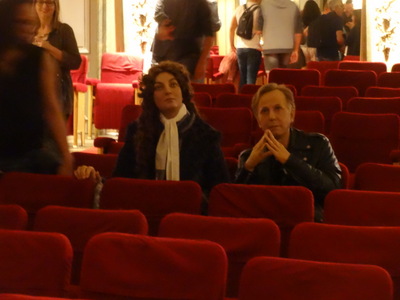
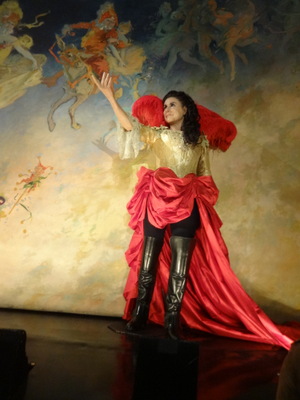 Here's a closer view of the couple in the seats. Any ideas?
Here's a closer view of the couple in the seats. Any ideas?
This wax lady was holding forth on the stage.
After the theater was a section on magic, including a skinny platform you could lie down on to look as though you were being levitated by the magician waving his hands over it. But it seemed to me that wax figures of magical illusions was shooting fish in a barrel—way easier to show a guy holding his head under his arm in a wax museum than on a live stage!
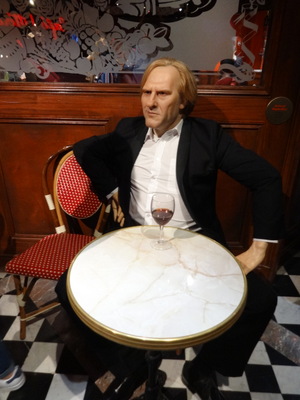
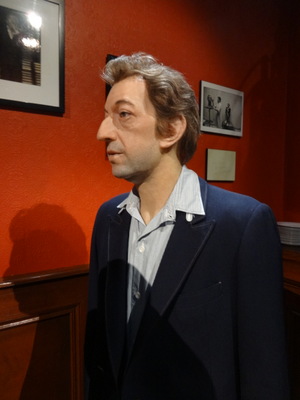 Next we passed through a section of café tables. Here's Gerard Depardieu sitting at one. Serge Gainesbourg looks on.
Next we passed through a section of café tables. Here's Gerard Depardieu sitting at one. Serge Gainesbourg looks on.
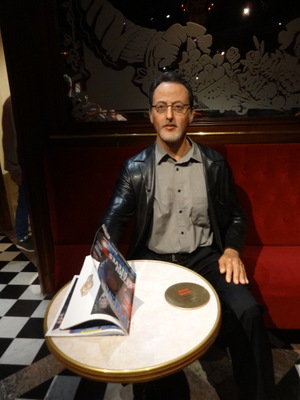
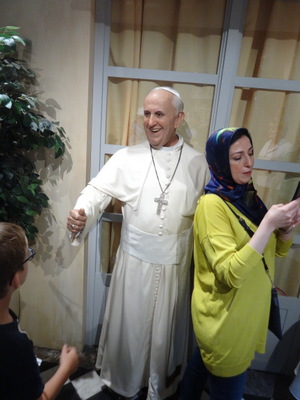 At another table is Jean Reno, and just around the corner from him, the pope welcomes all comers. The lady in green is a tourist.
At another table is Jean Reno, and just around the corner from him, the pope welcomes all comers. The lady in green is a tourist.
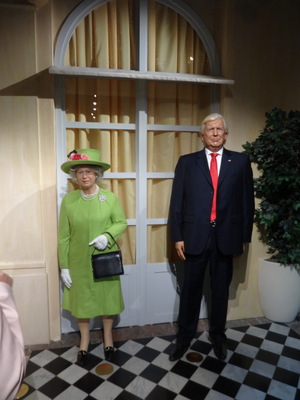
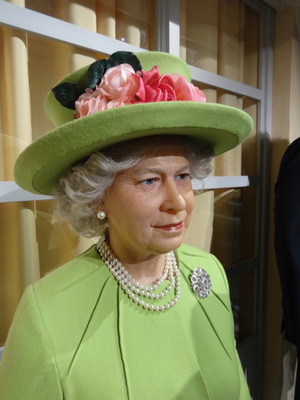 Queen Elizabeth is shown standing with Trump (but ignoring him). She looks pretty good, except that I don't think they got her hair right (but then again, maybe I've never seen it that close up before).
Queen Elizabeth is shown standing with Trump (but ignoring him). She looks pretty good, except that I don't think they got her hair right (but then again, maybe I've never seen it that close up before).
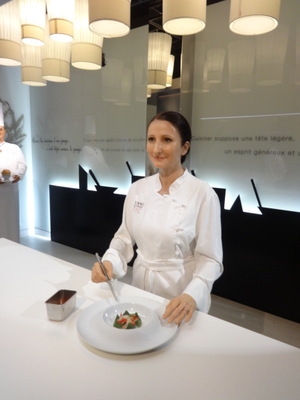
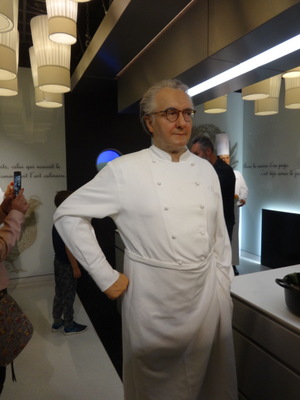 The culinary section featured only four chefs. At the left here is Anne-Sophie Pic. We ate at her place, La Dame de Pic (the Queen of Hearts) last year. You'd think that, as a successful business woman in a male-dominated field, she would know better than routinely to give menus without prices to female clients (especially when the reservation is in the woman's name and no indication has been given that the man with her is her husband), but she doesn't. Her waiters also ignored our repeated requests that they address us in French, not English.
The culinary section featured only four chefs. At the left here is Anne-Sophie Pic. We ate at her place, La Dame de Pic (the Queen of Hearts) last year. You'd think that, as a successful business woman in a male-dominated field, she would know better than routinely to give menus without prices to female clients (especially when the reservation is in the woman's name and no indication has been given that the man with her is her husband), but she doesn't. Her waiters also ignored our repeated requests that they address us in French, not English.
In the background, you can see part of Paul Bocuse. We didn't pose for a photo with his wax figure because we already have one with the real guy.
At the right is Alain Ducasse. The fourth figure was of Pierre Hermé, the macaroon guy. We agree that Bocuse and Ducasse belong in the hall of fame, but we can think of several chefs with whom we would replace Pic and Hermé<./p>
A few of those we passed and some of which I photographed, but that I have no space to include here, are Emmanuel Macron (as quite a young man), Einstein, Vercingetorix, Clovis, Hugues Capet (founder of the Capetian dynasty), Victor Hugo, Jean-Paul Sartre, De Gaulle (but not Eisenhauer), and many others.
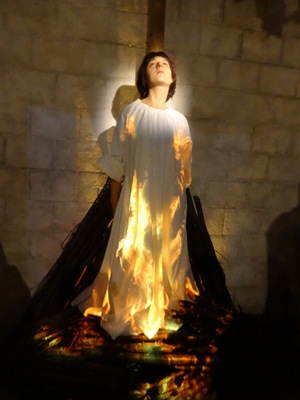
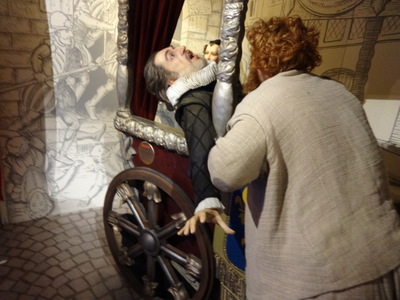 One section was of gruesome scenes. At the left here is Joan of Arc at the stake (the flames were projected and rippled realistically), and on the right, Henri IV being assassinated in his coach.
One section was of gruesome scenes. At the left here is Joan of Arc at the stake (the flames were projected and rippled realistically), and on the right, Henri IV being assassinated in his coach.
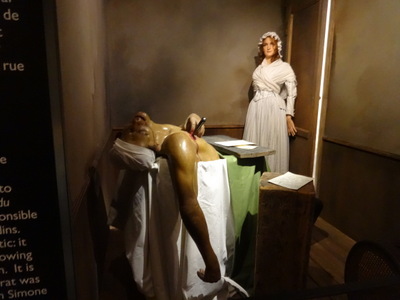
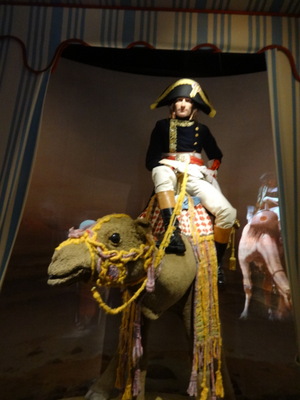 Then Marat, assassinated in his bath.
Then Marat, assassinated in his bath.
Around the corner from him was Napoleon in Egypt, complete with life-size camel (the camel was slightly less lifelike than Napoleon).
Napoleon also appeared in the more dignified familiar pose with his hand between buttons of his jacket. He was among only a few people important enough to be represented more than once: the only others I can think of were the pope and Michael Jackson.
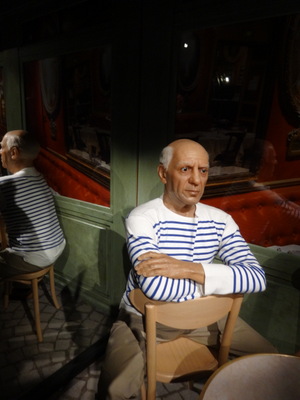
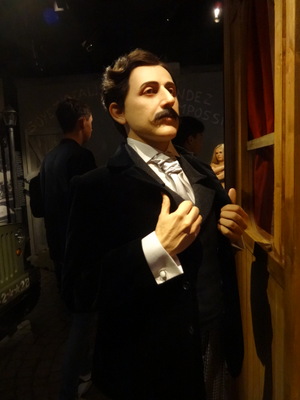 Picasso sat at another café table while Dali (not pictured) looked on. Dali's mustache was broken—some tourist got a little too friendly.
Picasso sat at another café table while Dali (not pictured) looked on. Dali's mustache was broken—some tourist got a little too friendly.
At the right is Marcel Proust, shown without his tea and madeleine.
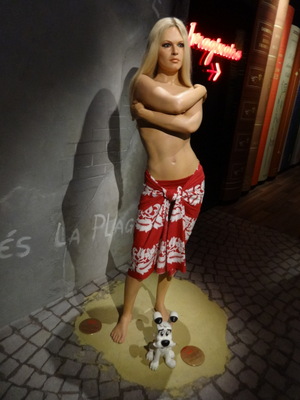
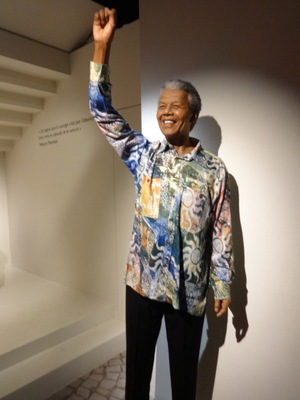 I think they started to run out of categories, because here Brigitte Bardot is pictured (at the right) with Idéfixe, Asterix's cartoon dog. Other cartoon characters were also portrayed, like Le Petit Prince and Skrat from Ice Age (again, shooting fish in a barrel).
I think they started to run out of categories, because here Brigitte Bardot is pictured (at the right) with Idéfixe, Asterix's cartoon dog. Other cartoon characters were also portrayed, like Le Petit Prince and Skrat from Ice Age (again, shooting fish in a barrel).
Strangely, standing right across from Brigitte was Nelson Mandela, waving to the crowd.
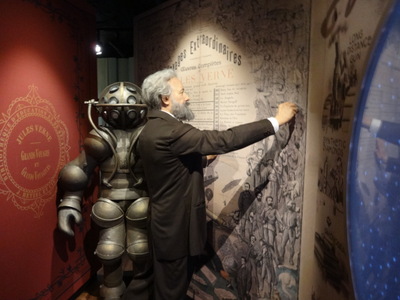
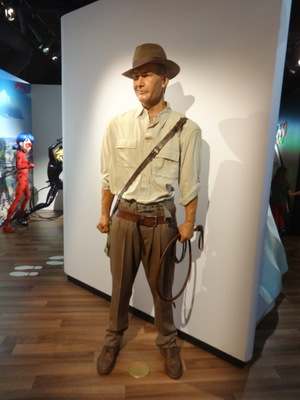 I couldn't resist including Jules Verne (left) and Indiana Jones (right). Boris Karloff was also there, made up as Frankenstein's monster.
I couldn't resist including Jules Verne (left) and Indiana Jones (right). Boris Karloff was also there, made up as Frankenstein's monster.
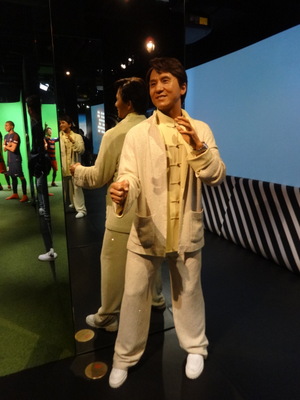
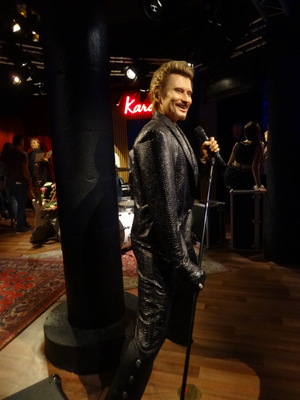 Here at the left is Jackie Chan, and at the right Jonny Halleyday, the French Elvis. Hallyday died in 2017, age 74. Elvis would have been in his eighties by then.
Here at the left is Jackie Chan, and at the right Jonny Halleyday, the French Elvis. Hallyday died in 2017, age 74. Elvis would have been in his eighties by then.
Also among the musicians, sports figures, and other celebrities were, for example, Pélé, Louis Armstrong, Katie Perry, Mick Jagger, and a whole host of French ones that didn't ring bells with me. Michael Jackson was portrayed twice, but Elvis was nowhere to be found. Nor the Beatles.
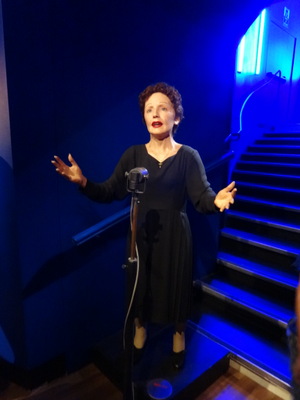
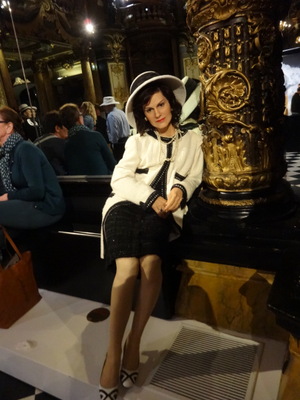 In another large hall, I found (among many, many others), Edith Piaf (standing on a box to reach the microphone, because she was so small), and Coco Chanel, lounging elegantly in a white jacket.
In another large hall, I found (among many, many others), Edith Piaf (standing on a box to reach the microphone, because she was so small), and Coco Chanel, lounging elegantly in a white jacket.
Also in that crowd were the six-year-old Mozart, George Clooney, Brad Pitt, Leonardo di Caprio, Barack Obama (but no other past presidents, even Eisenhauer), Marilyn Monroe, Alfred Hitchcock, and even that Australian male model who does all the Paco Raban ads. They gave his name, but I don't remember it. Plus all the other French ones I didn't know. And Barbie. I have no idea whether the little figure in the special glass case was a real Barbie or a wax figure of one.
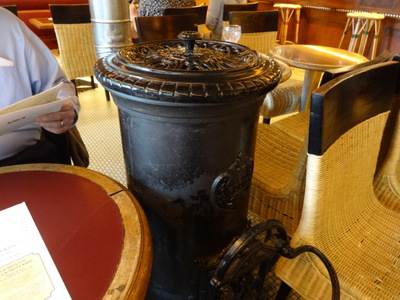
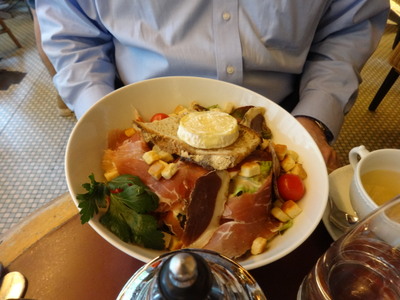 In years past, when we stayed at the Hotel Chopin, in the Passage Jouffroy, right next to the MUsée Grevin, we often had lunch at Le Café Zéphyr, just a couple of doors away, and we were delighted to find that it's still there! And it is resolutely French—no English on the menu, no offer to speak English to us (although reviews claim they will speak it if asked), same old (terrific, traditional) food—even though it's sandwiched between a Marks and Spencer on one side and on the other, Hard Rock Café, Starbucks, Chipotle, and McDonald's. And the hilariously named French chain Indiana Tex-Mex. I've never eaten there to find out whether the food they serve is really Tex-Mex as it might be interpreted in Indiana.
In years past, when we stayed at the Hotel Chopin, in the Passage Jouffroy, right next to the MUsée Grevin, we often had lunch at Le Café Zéphyr, just a couple of doors away, and we were delighted to find that it's still there! And it is resolutely French—no English on the menu, no offer to speak English to us (although reviews claim they will speak it if asked), same old (terrific, traditional) food—even though it's sandwiched between a Marks and Spencer on one side and on the other, Hard Rock Café, Starbucks, Chipotle, and McDonald's. And the hilariously named French chain Indiana Tex-Mex. I've never eaten there to find out whether the food they serve is really Tex-Mex as it might be interpreted in Indiana.
In the Zéphyr, we were seated next to this old iron stove (not in use at the time).
Although tempted by the house specialty, "truffade," we ordered our usual salads.
David had the "Rochebrune," with smoked duck breast, raw country ham, croutons, and a Rocadamour goat cheese on toast drizzled with honey.
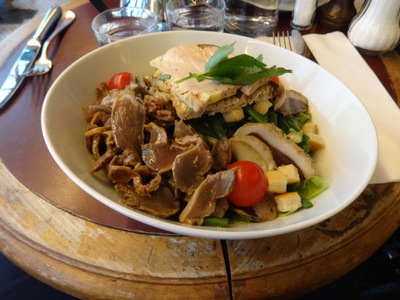
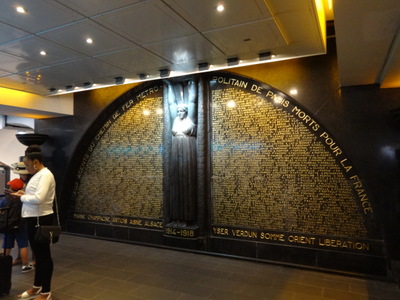 I had the "Gourmande," with green beans, croutons, confit gizzards, smoked duck breast, and duck foie gras on toast.
I had the "Gourmande," with green beans, croutons, confit gizzards, smoked duck breast, and duck foie gras on toast.
Both were yummy, and furthermore, the green beans were actually tender-crisp (and sweet) and not tough and crunchy, as that term is usually interpreted by American cooks.
To make truffade, as we were told right on the menu, you peel and slice potatoes and cook them in a large, covered skillet with a spoonful of butter. When they're golden and almost cooked, you stir in minced garlic, then add thin slices of fresh "tomme" cheese. Serve on heated plates and sprinkle with parsley. Gotta try that at home, sometime when we're not facing an eight-course dinner a few hours later.
Then home to rest up before the evening. In the Richelieu-Druot metro station (closest to the Zéphyr and the Grevin) was this memorial to all the employees of the metro who died for France in World War I. Most of the surface lists their names, and across the bottom is the list of battles where they died.
For the afternoon, I had planned (and prepurchased tickets for) a guided tour of the architecture of the Monnaie de Paris, the Paris Mint. Last year, we visited the mint's museum, which I learned just this year had only been open for a year or two when we saw it. Before that, the mint's museum had been mainly aimed at coin collectors. Now, I'd recommend it to anyone. But David's feet hurt, so he chose to stay at the apartment, and I went off to the mint by myself.
The most convenient route was to take the metro to the far end of the Louvre, then to walk back along the Seine a little ways before crossing the river on the Passerelle des Arts (the footbridge where lovers persisted in attaching padlocks to the metal mesh railings until the authorities replaced them with smooth plexiglas), then walking back the other way along the Seine to 11 Quai Conti, the mint's address. I allowed plenty of time, but I still only got there with about 10 minutes to spare, and I spent most of that trying to find someone who knew there was an architectural tour and where I should show up for it. A minute or two after I came in through the front gate and started asking around for the rendez-vous point, a guy showed up at the front gate and took profound offense at something one of the guards there said or did to him. (They were the usual guys with a little table, looking in handbags and ushering everyone through the metal detector). He got really incensed about it and starting shouting. I never did manage to make out what he was mad about (nor did the French folks nearby). He kept repeating to the guards, gendarmes, and even firemen who eventually showed up (firemen are always on duty at the major museums), "Do you hear me?! DO YOU HEAR ME?! He did [something unintelligible] to me!", and I have to admire his stamina—he was still shouting 20 minutes later when the tour finally got under way and we moved out of earshot. I even joked to the tour guide that his performance was so elaborate that perhaps he was the diversion for a robbery going on elsewhere in the building.
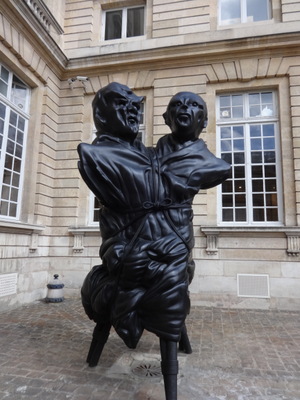
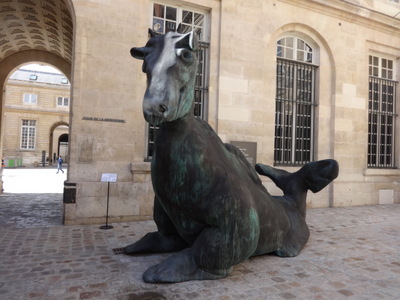 Before the tour started, though, I wandered around in the three main courtyards of the building and photographed some of the larger, outdoor pieces of the current temporary exhibition. Here at the left is United Enemies, two figures sharing obvious antipathy but but wrapped and tied together at the torso.
Before the tour started, though, I wandered around in the three main courtyards of the building and photographed some of the larger, outdoor pieces of the current temporary exhibition. Here at the left is United Enemies, two figures sharing obvious antipathy but but wrapped and tied together at the torso.
At the right is a piece more to my taste—a sort of sea creature, though I didn't get it's official title. Every 20 seconds or so, it blew steam out its nostrils. Near its front-most flipper, you can see the little permanent puddle formed by the subsequent drips.
Both pieces are by Thomas Schütte (born 1954 and living in Düsseldorf); the temporary exhibition is a retrospective of his work.
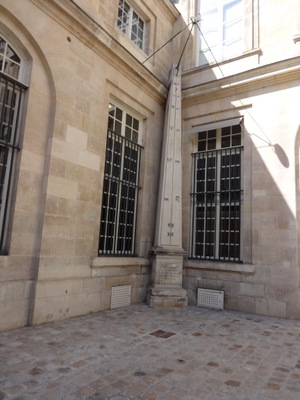
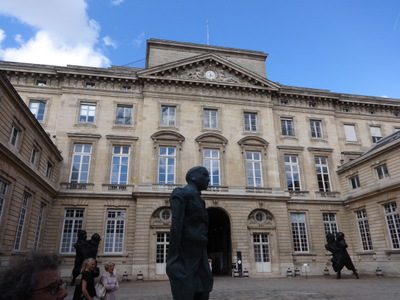 When you first enter the mint at 11 Conti, you're in the Cour d'Honneur, the largest and most decorative of the courtyards. Smaller ones branch off to the right and left. United Enemies was in a corner of the Cour d'Honneur, and the sea creature in the smaller Cour de Méridienne, which is the one to the left as you enter.
When you first enter the mint at 11 Conti, you're in the Cour d'Honneur, the largest and most decorative of the courtyards. Smaller ones branch off to the right and left. United Enemies was in a corner of the Cour d'Honneur, and the sea creature in the smaller Cour de Méridienne, which is the one to the left as you enter.
It's called that because it was carefully laid out such that the Paris meridian passes through it diagonally, exactly corner to corner. The vertical sundial shown at the left here is lined up exactly above it. The original architect chose the orientation specifically to "honor" the concept of the meridian. The Paris mint was built specifically to bring order and standardization to the French monetary system, as well as the system of weights and measures. The original meter stick, the standard on which the entire metric system and hence the weights of coins was based, is preserved here at the mint, although it is no longer the official standard. The length of the meter, intended to be used worldwide, is defined as a specific fraction of the length of a meridian, which is the same (at least theoretically, barring planetary lopsidedness) worldwide.
At the right is a view of as much of the Cour d'Honneur as I could fit in the frame, looking back toward the entrance from the street. The triangle at the top encloses a clock and two female allegorical figures, Justice and Plenty, maybe. Anyway, plenty is a major theme of the building. Cornucopias spilling fruit and/or coins are everywhere in the decor.
On the opposite wall of the cour is a semicircular recess sheltering five doors. Every morning, all the workers at the mint were mustered in the Cour d'Honneur for roll call, then the workers of each department (engraving, striking, etc.) were dispatched to the corresponding door.
Written 23 June 2019
One of the doors was headed "Blanchiment" (which can only means"whitening," although the usual modern term is "blanchissement"), so I was puzzled when both the guide and the French folks on the tour tittered with embarassment and the guide apologized for the embarrassing term and went on to assure us that back in the day it just meant washing the "flaons" (the coin blanks, today spelled "flans") with soap and water to get any dust or grease off them before they went on to be stamped into coins. I looked the word up later—today, it means "laundering," as in "money laundering." The more modern "blanchissement" means "laundering" as in washing clothes.
A sort of deambulatory runs around the sides and back of the main courtyard, to permit employees to circulate about their daily duties even while ceremonies were held in the courtyard (reception of foreign dignitaries, inspection by government officials, etc.).
Above the doors are four niches with the busts of French kings important in the history of French money. Henri II imported the first mechanical coin-striking machine, or "balancier," from the Netherlands, I think, but got no farther because the mint employees whose job it was to strike the coins by hand, with big hammers, complained that they would lose their jobs.
Two kings later, Louis XIII, was having none of that and enforced putting the coin striker into use, in the center of the first departments.
Louis XIV, a great numismatist, introduced monetary reform to France and instituted the Louis d'Or, the gold Louis, as the standard for all French currency. The Paris mint was built, in fact, to ensure that at least one French city produced coins you could have absolute confidence in. Every city in the country had a mint and produced coins of its own design for local use, and the local rulers often skimmed, producing coins that were under weight or contained more brass and less gold than they should. But the Latin inscription above the Cour d'Honneur says, "If it bears the Paris mint-mark, you can trust it."
Louis XV began constructing the building. Louis XVI finished it, but no room was allowed for a statute in his honor.
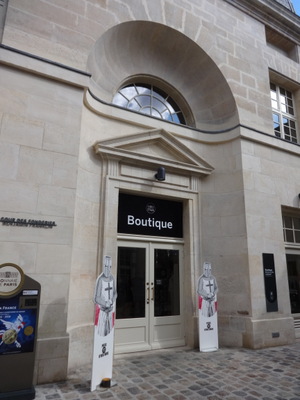
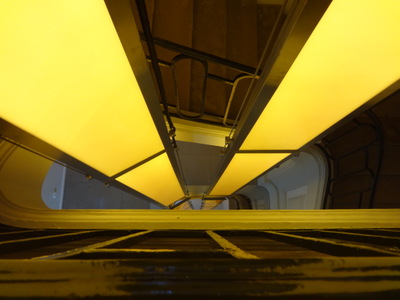 The architect of the recent huge renovation of the building was very big on mint symbolism. First, he wasn't allowed actually to touch most of the building, which is a historical monument, so he found ingenious ways to make his improvements and modernisations "float," existing within the building's interior spaces without actually touching the walls.
The architect of the recent huge renovation of the building was very big on mint symbolism. First, he wasn't allowed actually to touch most of the building, which is a historical monument, so he found ingenious ways to make his improvements and modernisations "float," existing within the building's interior spaces without actually touching the walls.
The work did uncover some original surfaces that had been built over in the past, including this nice "fronton" that happens to coincide with the door to the gift shop, off the right-hand side courtyard.
The photo at the right is of the lighting fixture that runs vertically up the center of a tall spiral staircase. I took the photo looking downward along it. It's supposed to represent "coulage," the pouring of molten metal (gold, I guess, from the color) into molds.
Another example is that the room I described last year, in which each metal used at the mint is displayed in its own lighted display case, is dark, to represent a mine. The only light comes from the display cases.
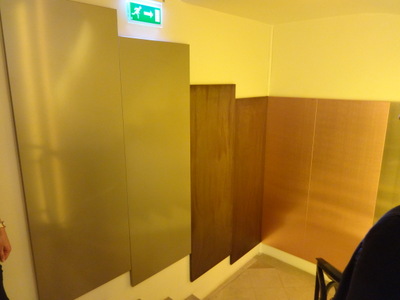
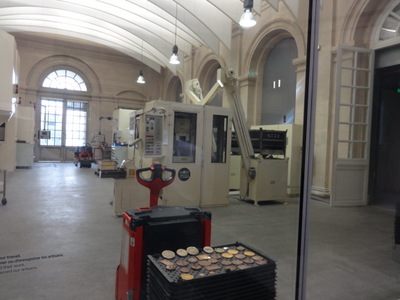 Around the sides of the staircase, the walls are paneled with these metal sheets of various colors, which are supposed to represent the precious-metal "placques" from which the "flans" are punched. They are decorative and not, as the guide hastened to assure us, actually made of gold, silver, and copper. Elsewhere in the building, the walls of the staircase are lined with perforated plaques, from which the "flans" have already been punched.
Around the sides of the staircase, the walls are paneled with these metal sheets of various colors, which are supposed to represent the precious-metal "placques" from which the "flans" are punched. They are decorative and not, as the guide hastened to assure us, actually made of gold, silver, and copper. Elsewhere in the building, the walls of the staircase are lined with perforated plaques, from which the "flans" have already been punched.
The plaques (some in the form of continuous rolls) are now made elsewhere, but originally they were made right on site, in the left-hand side courtyard. The yard is surrounded by doors that originally were those of stables where draft horses were kept. The floor of the courtyard was covered by a big stone slab onto which hot metal was poured. When it cooled to the proper consistency, the horses were harnessed to the ends of a huge stone roller, which was pulled back and forth to roll the metal out to the proper thickness for punching.
At the right is a photo through windows at the back of the room of the stamping room (the center of the five rooms opening off the main courtyard; the lighted glass door you can see opens to the main courthard)). It's still used for the same purpose—the rather clinical-looking machines in the photo are the modern "balanciers," now used only to stamp out commemorative medals (French coins are now made elsewhere, in a different mint).
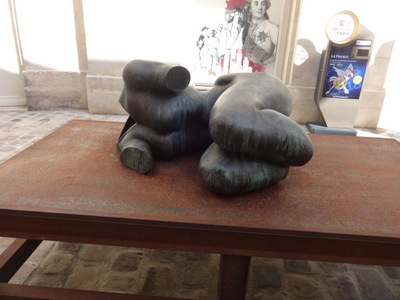
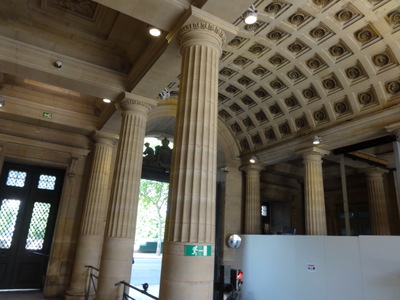 Passing through another courtyard, I got this photo of another Schütte piece, just called "torso."
Passing through another courtyard, I got this photo of another Schütte piece, just called "torso."
The photo at the right is of the coffered ceiling under which one passes to enter the main courtyard from the street. The man who had been shouting under it for so long had left by the time we passed back through it to visit the "apartments of state."
Near here, we also passed through a room where a frieze below the ceiling displayed the coats of arms of all the cities in France that had mints, together with the mint-marks with which they marked their coins.
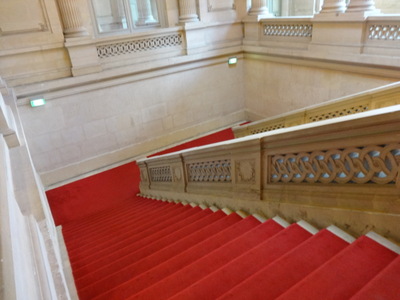
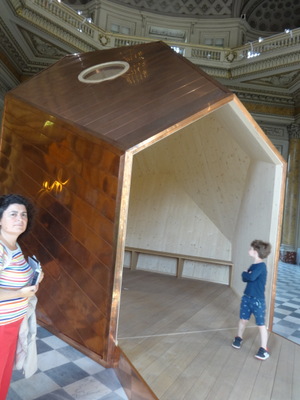 We then climbed this rather imposing, red-carpeted marble stairway to the rooms where official receptions were held.
We then climbed this rather imposing, red-carpeted marble stairway to the rooms where official receptions were held.
In one of them was permanently installed this "one-man house," copper clad on the outside, but inside paneled with fragrant unfinished pine. It's constructed of irregularly shaped polygons—most pentagons but a few four-sided pieces. It has a bench along one wall and one piece of art hangs on the wall (an ceramic disk about 18 inches across portraying a rough-hewn human face). In the ceiling are two round portholes intended, we were told, to focus your attention on particular elements of the decorated ceiling of the room.
That concluded the tour, a little short of 6:30 p.m. (the tours are only given at 5:00 p.m., and only one fell during our dates in Paris), and we had dinner reservations at 8:00 p.m. No time to fiddle with the Metro, so I just stepped across the street from the mint entrance and Ubered up a ride home. Nice Chinese driver, only on the job a few days, not much French or English. He had even entered his country of original into the Uber ap in Chinese characters because he didn't know how to write "China" in French (I asked him what they meant). But Uber's great that way—you and the driver need not have a common language. I didn't get home that much faster than Google claims I would have on the Metro, but way less hassle.
I got there with about 20 min in which to change clothes and pick up David before we set off again for the evening's restaurant, "Pur'" in the Hyatt Regency Place Vendôme, just north of the actual Place Vendôme. (Hotels are pretty cavalier about their naming conventions. That Hyatt was only a block or two from the actual place. Out here at the Hyatt Regency Paris Étoile, where I sit as I write this, we're more than two metro stops away from Étoile!)
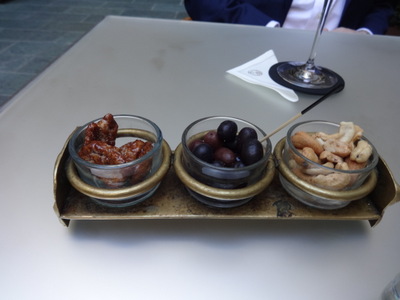
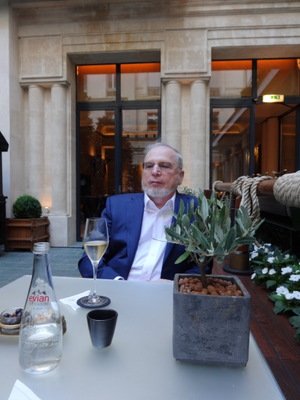 Estimating travel times on the metro is chancey, so we allowed plenty of time and got there early. Walking through the Place Vendôme, we encountered a "bus discoteque" headed the other way, so if you like that kind of thing, you can be assured they exist in Paris.
Estimating travel times on the metro is chancey, so we allowed plenty of time and got there early. Walking through the Place Vendôme, we encountered a "bus discoteque" headed the other way, so if you like that kind of thing, you can be assured they exist in Paris.
The restaurant only opened at 8:00, the time of our reservation, so when we walked into the hotel lobby and moved in that direction, we were deftly intercepted by a hostess and placed in the bar to wait. David was therefore able to start with his usual glass of champagne even before we got to our dinner table. The bar was in an interior courtyard open to the sky and had a nautical theme. Our cocktail waitress was accordingly dressed like a comic-opera sailor, and busy sparrows filled the air with what passes for birdsong in the middle of a city.
Once finally seated in the restaurant, we ordered the same big tasting menu we had last year—the "Carnet de Voyage"but of course it included all new dishes.
With the champagne, we were served three little munchies: candied pecans, niçoise olives, and herb-roasted cashews.
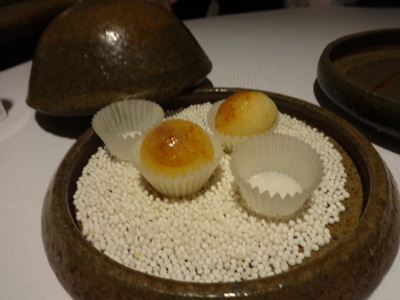
 The first amuse-bouche came in three parts: little spherical Brazilian cheese breads (tapioca flour based); tiny tartlets of sardines mashed and beaten up with fromage blanc; . . .
The first amuse-bouche came in three parts: little spherical Brazilian cheese breads (tapioca flour based); tiny tartlets of sardines mashed and beaten up with fromage blanc; . . .
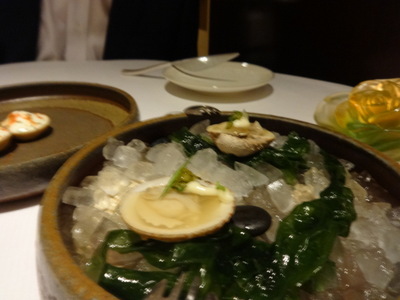
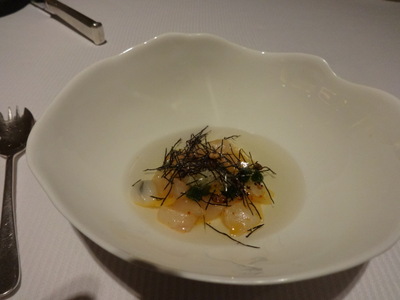 . . . and "praires" (warty venus clams, Venus verrucosa) jellied in their shells with "cedrat"(citron, Citrus medica) jelly.
. . . and "praires" (warty venus clams, Venus verrucosa) jellied in their shells with "cedrat"(citron, Citrus medica) jelly.
The second amuse-bouche was a little mound of raw bar (Ddicentrarchus labrax) and tiny shrimp (your guess is as good as mine; they didn't call them to species, and I'm not good at identifying crustaceans from nothing but the shelled and diced abdomen) with parsley, tiny shreds of black seaweed, and a few rags of Ulva. Individual citrus cells and some tiny green cubes of jelly that tasted citrusy. The waiter poured broth over it at the table. Yummy.
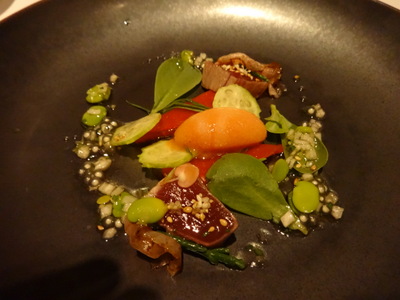
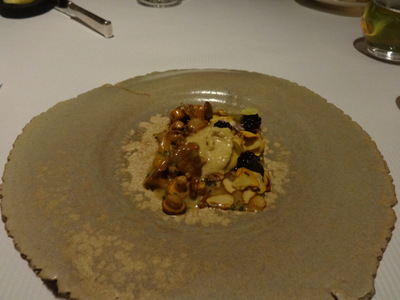 The first real course was tataki of red Mediterranean tuna with "carpaccio of watermelon" and piquillo peppers grilled with sesame oil.
The first real course was tataki of red Mediterranean tuna with "carpaccio of watermelon" and piquillo peppers grilled with sesame oil.
The second was "trouser-button" sized chanterelles with hazelnuts and wild blackberries, the way the chef's mother liked them.
The third, I forgot to photograph. The waiter delivers a dish and recites to you what's in it, and I get too caught up in trying to remember all the elements and record them on my pocket recorder that I then forget to take the picture. Drat. This happened to me over and over again this trip. At least at Pur', they show on the menu what the tasting menu consists of, so you can take a photo of that for the record, but in restaurants where every course is a surprise, I have no other record, so I have to pay close attention. Anyway, the third course was a quenelle of smoked sweet-corn ice cream with "imperial" caviar and "farofa" (toasted cassava flour). Delicious!
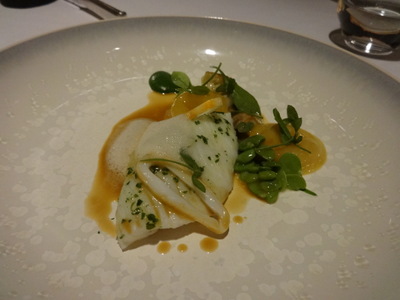
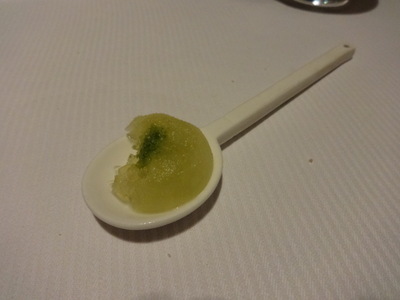 Fourth course was Saint-Pierre (Zeus faber, John Dory) and small squid rings with parsleyed butter, ravioli of sweet onion and preserved lemon, puree of citrus, a "poivrade" of baby artichokes and tiny fevettes (baby broad beans, individually peeled), and a saffron-flavored broth of "leaves" (whatever that means). The little arrowhead-shaped l might have been baby sorrel.
Fourth course was Saint-Pierre (Zeus faber, John Dory) and small squid rings with parsleyed butter, ravioli of sweet onion and preserved lemon, puree of citrus, a "poivrade" of baby artichokes and tiny fevettes (baby broad beans, individually peeled), and a saffron-flavored broth of "leaves" (whatever that means). The little arrowhead-shaped l might have been baby sorrel.
Palate-cleanser (not counted as a course): a frozen bonbon flavored with Chartreuse liqueur, sage, mint, and pineapple. Wow. I don't know what the little green bit of fruit or vegetable in the center was, but the whole thing was outstandingly delicious!
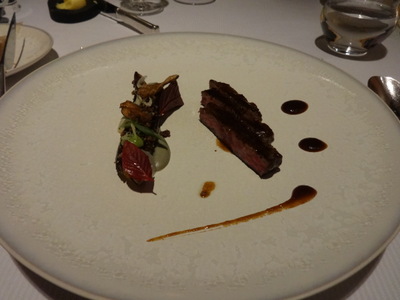
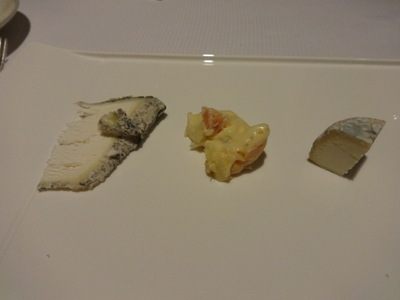 Fifth course: "Japwagyu" beef with "violet" eggplant, "Croncels" apple, heather honey, and ginger. Garanished with scallion shreds, opal basil, and little half-inch potato chips. Again, altogether yummy.
Fifth course: "Japwagyu" beef with "violet" eggplant, "Croncels" apple, heather honey, and ginger. Garanished with scallion shreds, opal basil, and little half-inch potato chips. Again, altogether yummy.
Sixth course: Cheese! At last a cheese trolley! David's selection, shown here, was Morbier (with the dark stripe of ash), farmstead Camembert, and Roquefort, with a prune chosen from the assortment of dried fruit offered.
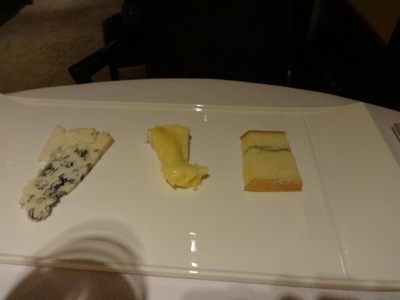
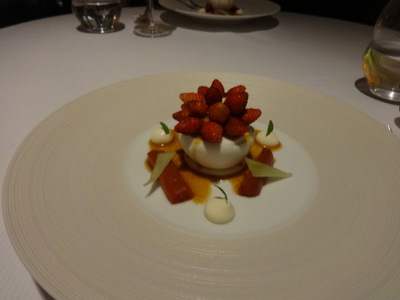 My choices were Valençay (no proteolysis at all, alas, and so dry that it needed to be eaten with a little butter, but delicious nonetheless), Soumaintrain (confined to its cyclindrical wooden box to keep it from crawling away and served with a spoon; I'd never had it before, but it looked like the same sort of thing—pâte molle, croûte lavée) as Époisse, which I like a lot), and a small dry chevre, which turned out to be the best of the lot (though all were great). I chose a dried fig, which unfortunately was overdried, almost crunchy.
My choices were Valençay (no proteolysis at all, alas, and so dry that it needed to be eaten with a little butter, but delicious nonetheless), Soumaintrain (confined to its cyclindrical wooden box to keep it from crawling away and served with a spoon; I'd never had it before, but it looked like the same sort of thing—pâte molle, croûte lavée) as Époisse, which I like a lot), and a small dry chevre, which turned out to be the best of the lot (though all were great). I chose a dried fig, which unfortunately was overdried, almost crunchy.
Seventh course: a strawberry and rhubarb vacherin. A crisp meringue shell was filled with ice cream and then topped and surrounded by "fraise des bois" (French wild strawberries) and logs of poached rhubarb. The little greenish triangles are raw rhubarb, which I ate one of before pushing the others to the side the of plate. The whole thing was sitting on a shortbread cookie, and I think that's mango sauce around it.
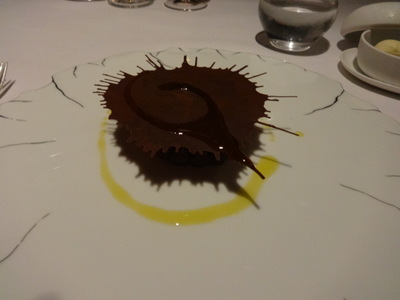
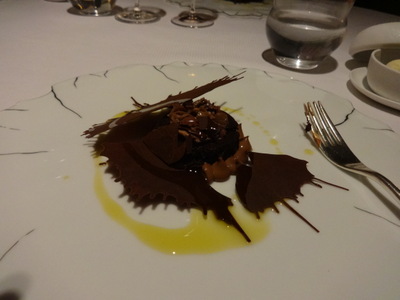 Eighth and last course: chocolate. The first course doesn't always have to be foie gras, and the meat course doesn't have to be beef; why does the last dessert always have to be chocolate?! After all those courses, I want something cold and light—strawberries or lime sorbet—not a great mass of cloying chocolate.
Eighth and last course: chocolate. The first course doesn't always have to be foie gras, and the meat course doesn't have to be beef; why does the last dessert always have to be chocolate?! After all those courses, I want something cold and light—strawberries or lime sorbet—not a great mass of cloying chocolate.
But I have to admit it was so good I ate it. At the left is the way it looked when delivered to the table. At the right, I've cracked the "crispy veil" of chocolate covering the dessert, so you can see underneath it the minced Taggiasca olives and the cream made with chocolate from "Papouasie" (Papua New Guinea and Asia?). The whole thing is surrounded by a drizzle of olive oil.
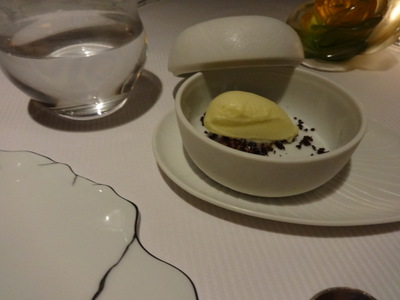 On the side, a quenelle of sweet olive oil ice cream.
On the side, a quenelle of sweet olive oil ice cream.
Definitely an outstanding meal. About the only thing I didn't like was the raw rhubarb (a tiny garnish) and the overdried fig (a minor problem). We like this place and would definite come back again.
Previous entry
List of Entries
Next entry

 Okay, time to break down and visit the Musée Grévin. We've passed it by many times, and have twice stayed at the Hotel Chopin, literally next door, without ever going in—it seemed so touristy—but if we're mopping up Paris attractions we've never visited . . .
Okay, time to break down and visit the Musée Grévin. We've passed it by many times, and have twice stayed at the Hotel Chopin, literally next door, without ever going in—it seemed so touristy—but if we're mopping up Paris attractions we've never visited . . .
 The first stop, which also serves to meter the number of people who enter the rest of the route at a time, is the hall of mirrors, a round room in which spectators lean against a circular wall provided for the purpose under an ornate eight-faceted dome paneled in mirrors.
The first stop, which also serves to meter the number of people who enter the rest of the route at a time, is the hall of mirrors, a round room in which spectators lean against a circular wall provided for the purpose under an ornate eight-faceted dome paneled in mirrors. 


 Then came a long series of rooms where wax figures were grouped in rough categories, e.g., the red carpet, politics, media, sports, music, fashion, fictional, scientific, culinary, historical, theatrical, etc., etc. I assume the figures are still actually made of wax, but they may be using more modern materials this days. In any case, some of them are amazingly life-like. I was a little surprised they don't hire mimes to pose as wax figures so as to startle you every now and then by moving, but maybe they don't have to—it was hard enough telling the figures from the tourists posing with them for photos!
Then came a long series of rooms where wax figures were grouped in rough categories, e.g., the red carpet, politics, media, sports, music, fashion, fictional, scientific, culinary, historical, theatrical, etc., etc. I assume the figures are still actually made of wax, but they may be using more modern materials this days. In any case, some of them are amazingly life-like. I was a little surprised they don't hire mimes to pose as wax figures so as to startle you every now and then by moving, but maybe they don't have to—it was hard enough telling the figures from the tourists posing with them for photos!
 Here, we're in a model of a famous French theater (I didn't catch which one). The slightly bedraggled figure at the right is Molière, greatest of French playwrights. Note that the figures are not protected by cases, foot rails, or even "do not cross" lines—they're right out there where you can walk up and touch them. In some sections, they stand with one arm out to the side so that you can pose beside them looking as though they have an arm behind your back.
Here, we're in a model of a famous French theater (I didn't catch which one). The slightly bedraggled figure at the right is Molière, greatest of French playwrights. Note that the figures are not protected by cases, foot rails, or even "do not cross" lines—they're right out there where you can walk up and touch them. In some sections, they stand with one arm out to the side so that you can pose beside them looking as though they have an arm behind your back.
 Here's a closer view of the couple in the seats. Any ideas?
Here's a closer view of the couple in the seats. Any ideas?
 Next we passed through a section of café tables. Here's Gerard Depardieu sitting at one. Serge Gainesbourg looks on.
Next we passed through a section of café tables. Here's Gerard Depardieu sitting at one. Serge Gainesbourg looks on.
 At another table is Jean Reno, and just around the corner from him, the pope welcomes all comers. The lady in green is a tourist.
At another table is Jean Reno, and just around the corner from him, the pope welcomes all comers. The lady in green is a tourist. 
 Queen Elizabeth is shown standing with Trump (but ignoring him). She looks pretty good, except that I don't think they got her hair right (but then again, maybe I've never seen it that close up before).
Queen Elizabeth is shown standing with Trump (but ignoring him). She looks pretty good, except that I don't think they got her hair right (but then again, maybe I've never seen it that close up before).
 The culinary section featured only four chefs. At the left here is Anne-Sophie Pic. We ate at her place, La Dame de Pic (the Queen of Hearts) last year. You'd think that, as a successful business woman in a male-dominated field, she would know better than routinely to give menus without prices to female clients (especially when the reservation is in the woman's name and no indication has been given that the man with her is her husband), but she doesn't. Her waiters also ignored our repeated requests that they address us in French, not English.
The culinary section featured only four chefs. At the left here is Anne-Sophie Pic. We ate at her place, La Dame de Pic (the Queen of Hearts) last year. You'd think that, as a successful business woman in a male-dominated field, she would know better than routinely to give menus without prices to female clients (especially when the reservation is in the woman's name and no indication has been given that the man with her is her husband), but she doesn't. Her waiters also ignored our repeated requests that they address us in French, not English.
 One section was of gruesome scenes. At the left here is Joan of Arc at the stake (the flames were projected and rippled realistically), and on the right, Henri IV being assassinated in his coach.
One section was of gruesome scenes. At the left here is Joan of Arc at the stake (the flames were projected and rippled realistically), and on the right, Henri IV being assassinated in his coach. 
 Then Marat, assassinated in his bath.
Then Marat, assassinated in his bath.
 Picasso sat at another café table while Dali (not pictured) looked on. Dali's mustache was broken—some tourist got a little too friendly.
Picasso sat at another café table while Dali (not pictured) looked on. Dali's mustache was broken—some tourist got a little too friendly.
 I think they started to run out of categories, because here Brigitte Bardot is pictured (at the right) with Idéfixe, Asterix's cartoon dog. Other cartoon characters were also portrayed, like Le Petit Prince and Skrat from Ice Age (again, shooting fish in a barrel).
I think they started to run out of categories, because here Brigitte Bardot is pictured (at the right) with Idéfixe, Asterix's cartoon dog. Other cartoon characters were also portrayed, like Le Petit Prince and Skrat from Ice Age (again, shooting fish in a barrel).
 I couldn't resist including Jules Verne (left) and Indiana Jones (right). Boris Karloff was also there, made up as Frankenstein's monster.
I couldn't resist including Jules Verne (left) and Indiana Jones (right). Boris Karloff was also there, made up as Frankenstein's monster.
 Here at the left is Jackie Chan, and at the right Jonny Halleyday, the French Elvis. Hallyday died in 2017, age 74. Elvis would have been in his eighties by then.
Here at the left is Jackie Chan, and at the right Jonny Halleyday, the French Elvis. Hallyday died in 2017, age 74. Elvis would have been in his eighties by then.
 In another large hall, I found (among many, many others), Edith Piaf (standing on a box to reach the microphone, because she was so small), and Coco Chanel, lounging elegantly in a white jacket.
In another large hall, I found (among many, many others), Edith Piaf (standing on a box to reach the microphone, because she was so small), and Coco Chanel, lounging elegantly in a white jacket.
 In years past, when we stayed at the Hotel Chopin, in the Passage Jouffroy, right next to the MUsée Grevin, we often had lunch at Le Café Zéphyr, just a couple of doors away, and we were delighted to find that it's still there! And it is resolutely French—no English on the menu, no offer to speak English to us (although reviews claim they will speak it if asked), same old (terrific, traditional) food—even though it's sandwiched between a Marks and Spencer on one side and on the other, Hard Rock Café, Starbucks, Chipotle, and McDonald's. And the hilariously named French chain Indiana Tex-Mex. I've never eaten there to find out whether the food they serve is really Tex-Mex as it might be interpreted in Indiana.
In years past, when we stayed at the Hotel Chopin, in the Passage Jouffroy, right next to the MUsée Grevin, we often had lunch at Le Café Zéphyr, just a couple of doors away, and we were delighted to find that it's still there! And it is resolutely French—no English on the menu, no offer to speak English to us (although reviews claim they will speak it if asked), same old (terrific, traditional) food—even though it's sandwiched between a Marks and Spencer on one side and on the other, Hard Rock Café, Starbucks, Chipotle, and McDonald's. And the hilariously named French chain Indiana Tex-Mex. I've never eaten there to find out whether the food they serve is really Tex-Mex as it might be interpreted in Indiana.
 I had the "Gourmande," with green beans, croutons, confit gizzards, smoked duck breast, and duck foie gras on toast.
I had the "Gourmande," with green beans, croutons, confit gizzards, smoked duck breast, and duck foie gras on toast.
 Before the tour started, though, I wandered around in the three main courtyards of the building and photographed some of the larger, outdoor pieces of the current temporary exhibition. Here at the left is United Enemies, two figures sharing obvious antipathy but but wrapped and tied together at the torso.
Before the tour started, though, I wandered around in the three main courtyards of the building and photographed some of the larger, outdoor pieces of the current temporary exhibition. Here at the left is United Enemies, two figures sharing obvious antipathy but but wrapped and tied together at the torso. 
 When you first enter the mint at 11 Conti, you're in the Cour d'Honneur, the largest and most decorative of the courtyards. Smaller ones branch off to the right and left. United Enemies was in a corner of the Cour d'Honneur, and the sea creature in the smaller Cour de Méridienne, which is the one to the left as you enter.
When you first enter the mint at 11 Conti, you're in the Cour d'Honneur, the largest and most decorative of the courtyards. Smaller ones branch off to the right and left. United Enemies was in a corner of the Cour d'Honneur, and the sea creature in the smaller Cour de Méridienne, which is the one to the left as you enter. 
 The architect of the recent huge renovation of the building was very big on mint symbolism. First, he wasn't allowed actually to touch most of the building, which is a historical monument, so he found ingenious ways to make his improvements and modernisations "float," existing within the building's interior spaces without actually touching the walls.
The architect of the recent huge renovation of the building was very big on mint symbolism. First, he wasn't allowed actually to touch most of the building, which is a historical monument, so he found ingenious ways to make his improvements and modernisations "float," existing within the building's interior spaces without actually touching the walls.
 Around the sides of the staircase, the walls are paneled with these metal sheets of various colors, which are supposed to represent the precious-metal "placques" from which the "flans" are punched. They are decorative and not, as the guide hastened to assure us, actually made of gold, silver, and copper. Elsewhere in the building, the walls of the staircase are lined with perforated plaques, from which the "flans" have already been punched.
Around the sides of the staircase, the walls are paneled with these metal sheets of various colors, which are supposed to represent the precious-metal "placques" from which the "flans" are punched. They are decorative and not, as the guide hastened to assure us, actually made of gold, silver, and copper. Elsewhere in the building, the walls of the staircase are lined with perforated plaques, from which the "flans" have already been punched.
 Passing through another courtyard, I got this photo of another Schütte piece, just called "torso."
Passing through another courtyard, I got this photo of another Schütte piece, just called "torso."
 We then climbed this rather imposing, red-carpeted marble stairway to the rooms where official receptions were held.
We then climbed this rather imposing, red-carpeted marble stairway to the rooms where official receptions were held. 
 Estimating travel times on the metro is chancey, so we allowed plenty of time and got there early. Walking through the Place Vendôme, we encountered a "bus discoteque" headed the other way, so if you like that kind of thing, you can be assured they exist in Paris.
Estimating travel times on the metro is chancey, so we allowed plenty of time and got there early. Walking through the Place Vendôme, we encountered a "bus discoteque" headed the other way, so if you like that kind of thing, you can be assured they exist in Paris.
 The first amuse-bouche came in three parts: little spherical Brazilian cheese breads (tapioca flour based); tiny tartlets of sardines mashed and beaten up with fromage blanc; . . .
The first amuse-bouche came in three parts: little spherical Brazilian cheese breads (tapioca flour based); tiny tartlets of sardines mashed and beaten up with fromage blanc; . . .

 . . . and "praires" (warty venus clams, Venus verrucosa) jellied in their shells with "cedrat"(citron, Citrus medica) jelly.
. . . and "praires" (warty venus clams, Venus verrucosa) jellied in their shells with "cedrat"(citron, Citrus medica) jelly. 
 The first real course was tataki of red Mediterranean tuna with "carpaccio of watermelon" and piquillo peppers grilled with sesame oil.
The first real course was tataki of red Mediterranean tuna with "carpaccio of watermelon" and piquillo peppers grilled with sesame oil.
 Fourth course was Saint-Pierre (Zeus faber, John Dory) and small squid rings with parsleyed butter, ravioli of sweet onion and preserved lemon, puree of citrus, a "poivrade" of baby artichokes and tiny fevettes (baby broad beans, individually peeled), and a saffron-flavored broth of "leaves" (whatever that means). The little arrowhead-shaped l might have been baby sorrel.
Fourth course was Saint-Pierre (Zeus faber, John Dory) and small squid rings with parsleyed butter, ravioli of sweet onion and preserved lemon, puree of citrus, a "poivrade" of baby artichokes and tiny fevettes (baby broad beans, individually peeled), and a saffron-flavored broth of "leaves" (whatever that means). The little arrowhead-shaped l might have been baby sorrel.
 Fifth course: "Japwagyu" beef with "violet" eggplant, "Croncels" apple, heather honey, and ginger. Garanished with scallion shreds, opal basil, and little half-inch potato chips. Again, altogether yummy.
Fifth course: "Japwagyu" beef with "violet" eggplant, "Croncels" apple, heather honey, and ginger. Garanished with scallion shreds, opal basil, and little half-inch potato chips. Again, altogether yummy.
 My choices were Valençay (no proteolysis at all, alas, and so dry that it needed to be eaten with a little butter, but delicious nonetheless), Soumaintrain (confined to its cyclindrical wooden box to keep it from crawling away and served with a spoon; I'd never had it before, but it looked like the same sort of thing—pâte molle, croûte lavée) as Époisse, which I like a lot), and a small dry chevre, which turned out to be the best of the lot (though all were great). I chose a dried fig, which unfortunately was overdried, almost crunchy.
My choices were Valençay (no proteolysis at all, alas, and so dry that it needed to be eaten with a little butter, but delicious nonetheless), Soumaintrain (confined to its cyclindrical wooden box to keep it from crawling away and served with a spoon; I'd never had it before, but it looked like the same sort of thing—pâte molle, croûte lavée) as Époisse, which I like a lot), and a small dry chevre, which turned out to be the best of the lot (though all were great). I chose a dried fig, which unfortunately was overdried, almost crunchy.
 Eighth and last course: chocolate. The first course doesn't always have to be foie gras, and the meat course doesn't have to be beef; why does the last dessert always have to be chocolate?! After all those courses, I want something cold and light—strawberries or lime sorbet—not a great mass of cloying chocolate.
Eighth and last course: chocolate. The first course doesn't always have to be foie gras, and the meat course doesn't have to be beef; why does the last dessert always have to be chocolate?! After all those courses, I want something cold and light—strawberries or lime sorbet—not a great mass of cloying chocolate. On the side, a quenelle of sweet olive oil ice cream.
On the side, a quenelle of sweet olive oil ice cream.